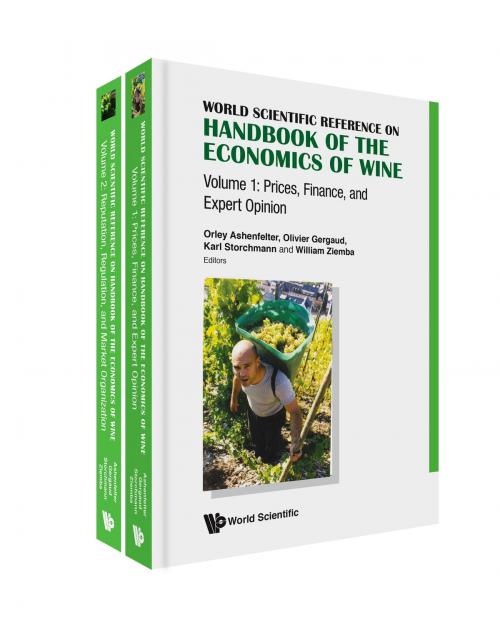Handbook of the Economics of Wine
(In 2 Volumes) - Volume 1: Prices, Finance, and Expert Opinion; Volume 2: Reputation, Regulation, and Market Organization
Business & Finance, Human Resources & Personnel Management, Organizational Behavior, Economics| Author: | Orley Ashenfelter, Olivier Gergaud, Karl Storchmann;William Ziemba | ISBN: | 9789813232730 |
| Publisher: | World Scientific Publishing Company | Publication: | March 21, 2018 |
| Imprint: | WSPC | Language: | English |
| Author: | Orley Ashenfelter, Olivier Gergaud, Karl Storchmann;William Ziemba |
| ISBN: | 9789813232730 |
| Publisher: | World Scientific Publishing Company |
| Publication: | March 21, 2018 |
| Imprint: | WSPC |
| Language: | English |
Over the last three decades, wine economics has emerged as a growing field within agricultural economics, but also in other fields such as finance, trade, growth, environmental economics and industrial organization. Wine has a few characteristics that differentiate it from other agricultural commodities, rendering it an interesting topic for economists in general. Fine wine can regularly fetch bottle prices that exceed several thousand dollars. It can be stored a long time and may increase in value with age. Fine wine quality and prices are extraordinarily sensitive to fluctuations in the weather of the year in which the grapes were grown. And wine is an experience good, i.e., its quality cannot be ascertained before consumption. As a result, consumers often rely on "expert opinion" regarding quality and maturation prospects.
This handbook takes a broad approach and familiarizes the reader with the main research strands in wine economics.
After a general introduction to wine economics by Karl Storchmann, Volume 1 focuses on the core areas of wine economics. The first papers shed light on the relevance of the vineyard's natural environment for wine quality and prices. "Predicting the Quality and Prices of Bordeaux Wine" by Orley Ashenfelter is a classic paper and may be the first wine economics publication ever. Ashenfelter shows how weather influences the quality and the price of Bordeaux Grands Crus wine. Since the weather condition of the year when the grapes were grown is known, an econometric analysis may be constructed. It turns out this model outperforms expert opinion, i.e., critical vintage scores. At best, expert opinion reflects public information. The subsequent papers, by Ashenfelter and Storchmann, Gergaud and Ginsburgh, and Cross, Plantinga and Stavins, tackle the terroir question. That is, they examine the relevance of a vineyard's physical characteristics for wine quality and prices, but from various dimensions and with different results. Next, Alston et al. analyze a question of great concern in the California wine industry: the causes and consequences of the rising alcohol content in California wine. Is climate change the culprit?
The next chapter presents three papers that apply hedonic price analyses to fine wine. Combris, Lecocq and Visser show that Bordeaux wine market prices are essentially determined by the wines' objective characteristics. Costanigro, McCluskey and Mittelhammer differentiate their hedonic analysis for various market segments. Ali and Nauges incorporate reputational variables into their pricing model and distinguish between short- and long-run price effects.
The next section of this volume deals with one of the unique characteristics of wine — its long storage life, which makes it potentially an investment asset.
The last two chapters examine the role of wine experts. First, Ashenfelter and Quandt revisit the 1976 "Judgment of Paris" and show that aggregating the assessments of several judges should go beyond "adding points." Depending on the method employed, the results may vary, and some measure of statistical precision is essential for interpreting the reliability of the results. In two different papers, Cicchetti and Quandt respond to the necessity to provide statistical tools for the assessment of wine tastings.
Volume 2 covers the topics reputation, regulation, auctions, and market organizational. Landon and Smith, Anderson and Schamel, and Schamel analyze the impact of current quality and reputation (i.e., past quality) on wine prices from different regions. Their results suggest that prices are more influenced by reputation than by current quality. Costanigro, McCluskey and Goemans develop a nested framework for jointly examining the effects of product, firm and collective reputation on market prices.
Readership: Graduate students and specialists in the field of wine economics.
Over the last three decades, wine economics has emerged as a growing field within agricultural economics, but also in other fields such as finance, trade, growth, environmental economics and industrial organization. Wine has a few characteristics that differentiate it from other agricultural commodities, rendering it an interesting topic for economists in general. Fine wine can regularly fetch bottle prices that exceed several thousand dollars. It can be stored a long time and may increase in value with age. Fine wine quality and prices are extraordinarily sensitive to fluctuations in the weather of the year in which the grapes were grown. And wine is an experience good, i.e., its quality cannot be ascertained before consumption. As a result, consumers often rely on "expert opinion" regarding quality and maturation prospects.
This handbook takes a broad approach and familiarizes the reader with the main research strands in wine economics.
After a general introduction to wine economics by Karl Storchmann, Volume 1 focuses on the core areas of wine economics. The first papers shed light on the relevance of the vineyard's natural environment for wine quality and prices. "Predicting the Quality and Prices of Bordeaux Wine" by Orley Ashenfelter is a classic paper and may be the first wine economics publication ever. Ashenfelter shows how weather influences the quality and the price of Bordeaux Grands Crus wine. Since the weather condition of the year when the grapes were grown is known, an econometric analysis may be constructed. It turns out this model outperforms expert opinion, i.e., critical vintage scores. At best, expert opinion reflects public information. The subsequent papers, by Ashenfelter and Storchmann, Gergaud and Ginsburgh, and Cross, Plantinga and Stavins, tackle the terroir question. That is, they examine the relevance of a vineyard's physical characteristics for wine quality and prices, but from various dimensions and with different results. Next, Alston et al. analyze a question of great concern in the California wine industry: the causes and consequences of the rising alcohol content in California wine. Is climate change the culprit?
The next chapter presents three papers that apply hedonic price analyses to fine wine. Combris, Lecocq and Visser show that Bordeaux wine market prices are essentially determined by the wines' objective characteristics. Costanigro, McCluskey and Mittelhammer differentiate their hedonic analysis for various market segments. Ali and Nauges incorporate reputational variables into their pricing model and distinguish between short- and long-run price effects.
The next section of this volume deals with one of the unique characteristics of wine — its long storage life, which makes it potentially an investment asset.
The last two chapters examine the role of wine experts. First, Ashenfelter and Quandt revisit the 1976 "Judgment of Paris" and show that aggregating the assessments of several judges should go beyond "adding points." Depending on the method employed, the results may vary, and some measure of statistical precision is essential for interpreting the reliability of the results. In two different papers, Cicchetti and Quandt respond to the necessity to provide statistical tools for the assessment of wine tastings.
Volume 2 covers the topics reputation, regulation, auctions, and market organizational. Landon and Smith, Anderson and Schamel, and Schamel analyze the impact of current quality and reputation (i.e., past quality) on wine prices from different regions. Their results suggest that prices are more influenced by reputation than by current quality. Costanigro, McCluskey and Goemans develop a nested framework for jointly examining the effects of product, firm and collective reputation on market prices.
Readership: Graduate students and specialists in the field of wine economics.















